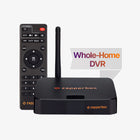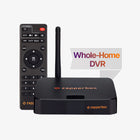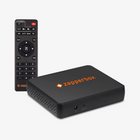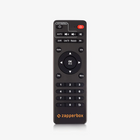
Posted on Dec 9, 2024 and updated Sep 5, 2025
This article describes the issues one must consider in designing an antenna signal distribution system to feed a quad tuner receiver. It has been updated after we posted this companion article about OTA Signal Distribution.
A quad tuner or even a dual tuner receiver poses some challenges compared to a single tuner receiver. Each RF splitter reduces signal power through insertion loss. Splitters do not reduce the noise figure by a corresponding amount, so you are directly reducing the signal-to-noise ratio of the TV signals by the amount of loss at each split.
In an ideal world, a 2-way split reduces signal by 3dB, a 4-way by 6dB, and an 8-way by 9 dB. But we don’t live in an ideal world, and some splitters are better designed and use higher-quality components than others. Actual losses are usually 0.5-1.0dB more per split. These losses are labeled as insertion loss.
We often get complaints from customers who compare the weak signal performance of their dual-tuner ZapperBox against their TV. That’s an unfair comparison because the TV is not splitting the signal internally. Further, as you add more tuners inside a single, size-constrained, low-cost set-top box, it becomes difficult to avoid interference between the tuners.
However, the fear of signal loss due to signal splits is unfounded. Our article titled "OTA Signal Distribution for Homes or Hotels" presents three different solutions for correctly amplifying and distributing the signal from an antenna to multiple ZapperBox devices and TVs in a home or even a large living facility with hundreds of receivers. These range form a simple three-band amplifier with overamplification protection to two units with 32 discreet RF band amplifiers along with other strategies to correctly load balance multiple signal splits.
Also see this blog post by Bob Haines about using Avant X with ZapperBox.
By implementing these strategies, you can significantly reduce the overall insertion loss in a system using multiple splitters and maximize the number of watchable channels.
Prologue – by Javier Ruano, GM at Televes USA
This is why a properly pre-amplified system is always preferred. Ideally, a pre-amplified antenna, like the ZapperBox A1 antenna by Televes, conditions the signal and separates it from the thermal Noise Figure as soon as possible. The reason is simple: in a purely passive signal captured from a passive antenna, the noise figure is set. Any loss in signal, be it from a splitter or cable loss, is a direct loss of Carrier-to-Noise Ratio (CNR). The signal gets attenuated, the Noise Figure doesn’t. If you pre-amplify the signal at the acquisition point with a proper preamp, that only penalizes you for the Noise Figure of the preamplifier (which should be low in a properly designed unit), but the signal gets separated from the thermal Noise Figure and any losses in power due to splitting or cable, are not a loss of CNR anymore, they are only a loss of power. The CNR or signal quantity remains constant. Furthermore, the Noise Figure of the first element in the system determines the Noise Figure of the rest of the chain. A properly designed preamplifier establishes that and “negates” the detrimental effect of other actives in the chain downstream, such as the Noise Figure of the tuner itself. Pre-amplifying the signal at the antenna negates the Noise Figure of the tuner. That’s why sometimes it appears that a system “gains channels” by adding a preamp. Now, what are the potential issues of using a preamp? Obviously, overload, under- or over amplification. We solve that because we make our preamps self-adjusting, so that they never apply too much amplification. The other one is being overloaded by out-of-band signals. We avoid that with very strict filtering.




